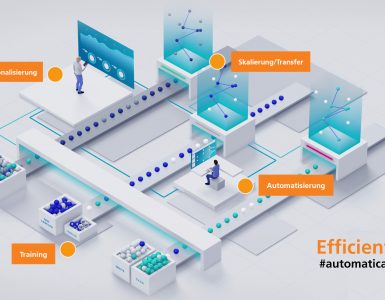Wie Daten für KI-Verfahren nutz- und interpretierbar gemacht werden
In der neuen Podcastepisode mit Thomas Wittenberg geht es wie in der letzten Folge um einen Bereich aus Grundlagenforschung, der erhobene Daten für KI-Verfahren erst nutzbar macht: Semantik.
Was ist Semantik?
Semantik sorgt dafür, dass Daten und Datenstrukturen formal definiert, standardisiert und eindeutig beschrieben sind. So müssen bei Industrie 4.0 verschiedenste Entitäten wie Sensoren, Produkte, Maschinen oder Transportsysteme in der Lage sein, deren Eigenschaften, Fähigkeiten oder Zustände anderer Entitäten in der Wertschöpfungskette zu interpretieren. In dieser Podcastfolge erklärt Thomas Wittenberg, warum »Semantik« als Basis für jede KI-Anwendung so wichtig ist und welche Herausforderungen, Verfahren und Anwendungsbeispiele es in dieser Kompetenzsäule gibt.
Daten sind die Basis für jegliche Verarbeitung in KI-Verfahren. In der Podcastfolge zu Few Data Learning hat Dr. Christian Menden berichtet, wie fehlerhafte oder kleine Datensätze erweitert werden, damit Machine Learning (ML)-Methoden angewendet werden können. Allein mit dem Vorhandensein von vielen Daten können jedoch immer noch keine ML-Verfahren genutzt werden. Erst durch Semantik werden Daten für Mensch und Maschine interpretierbar und somit nutzbar gemacht. Es werden also vorhandene Daten wie Bilder, Videos, Zeitreihen und Texte mit dem zugehörigen Wissen über die Daten, der Semantik, gekoppelt.
Dafür gibt es unterschiedliche Herangehensweisen – einige beschreibt Thomas anhand von Applikationen in dieser Podcastfolge. Hören Sie jetzt rein!
How data is made usable and interpretable for AI processes in the first place
In the new podcast episode with Thomas Wittenberg, as in the previous episode, the focus is on an area of basic research that makes datasets usable for AI processes in the first place: semantics.
What is semantics?
Semantics ensures that data and data structures are formally defined, standardized, consistent and unambiguously described. In Industrie 4.0, for example, a wide variety of entities (such as sensors, products, machines, or transport systems) must be able to interpret their properties, capabilities, or states of other entities in the value chain. In this podcast episode, I talk with Thomas Wittenberg about why semantics is so important as the basis for any AI applications and what the challenges, processes and use cases are in this pillar.
Data is the basis for any processing in AI procedures. In the last podcast episode, Dr. Christian Menden shared how erroneous or small data sets can be augmented to allow ML methods to be applied. However, simply having a lot of data still does not allow ML methods to be used. It is only through semantics that data can be interpreted by humans and machines and therefore made usable. This means that existing data such as images, videos, time series and texts are coupled with the associated knowledge about the data, the semantics.
There are different approaches to this – Thomas describes three of them using applications in this podcast episode. Enjoy listening!





